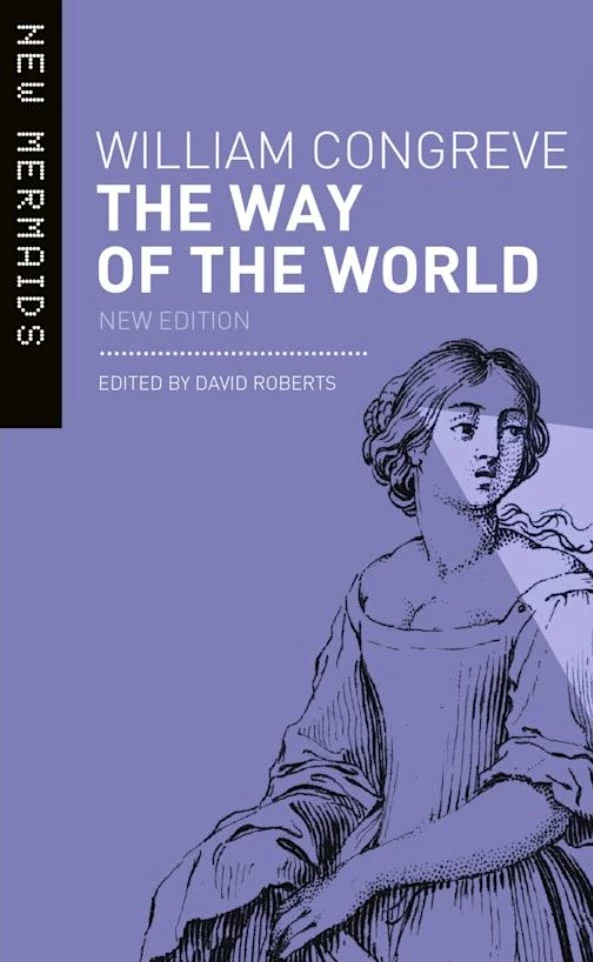“The Way of The World” by William Congreve digresses from Traditional Restoration Themes, Yet Extraordinary for Readers ( Year: 1700)

Premiered firstly in London Theater in 1700, William Congreve’s “The Way of The World” is a Restoration Comedy of Manners that crucially exposes the loose-moral standards, adulterous behaviour and sexual scandals of the sophisticated aristocratic class in England to highlight their fragile meanings of marriage, sex, love and money under Charles-II monarchy. Even though the names of the characters, Congreve has attempted to reflect the perspective and personality traits of these figures- like Mr Fainall is the character who fains all time according to circumstances while Mrs Wishfort is the one who has sexual wishes for Mirabell and marrying Sir Rowland. Since it is performed during the period of emerging materialism and commerce, it has also adopted money as an important theme in the play and like many Restoration comedies, it also contains flawed high-status characters, witty language and satire to generate humour but apart from that, the play also digressed from the predefined features of Restoration Comedy to provide a newer-outlook to the audience while conforming to the similar social standards.
Through this article, I intend to primarily analyze the features of Restoration Comedy in Congreve’s “The Way of the World” and secondarily compare it with Aphra Behn’s “The Rover” to broadly understand how and why Congreve digress from the pre-described traditions of Restoration comedy and still managed to create a compelling masterpiece for many generations of readers.
Contextually, aftermath the disintegration of restrictive and conservative Puritan regimes in 1660, the monarchical government rule of Charles-II was restored in England who lifted the prohibitions on the literature and reopened the theatres during his regime and this historical period is popularly termed as the Restoration Period. Out of many impacts of the transition of political power from Puritans to Charles-II, the prominent one was that the authors and playwrights gained freedom of speech and expression of their thoughts in sexually explicit language which loosened the restraints on the artists. Even the historian George Norman Clarke writes- “The best-known fact about the Restoration drama is that it is immoral. The dramatists did not criticize the accepted morality about gambling, drink, love….What they did was, according to their respective inclinations, to mock at all restraints…..The dramatists did not merely say anything they liked: they also intended to glory in it and to shock those who did not like it.” As a consequence of freedom of literary expression, the themes of scandalous marriage, sex, love and money came on the forefront that revealed the stark social reality of aristocracy in England as echoed in literature like Pope’s “The Rape of Lock” and comedy like Aphra Behn’s “The Rover.”
Like a Restoration Comedy, Congreve’s “The Way of the World” has also noble aristocratic characters like Mr Fainall, Mirabell and Lady Wishfort who overvalue fashion and mannerisms like gallantry more than ethical codes; it has fops like Witwood and Petulant who overvalue external appearance more than internal beauty; and its theme also revolves around the love affair of Mirabell and Millamant but in addition to these traditional aspects of Restoration Comedy, Congreve had also utilized certain features like reformed rake and coquette characters, the liberating performative personal space to female characters and Proviso scene etc. in the play that digresses from norms of those days which primarily amplify the intensity of social satire and secondarily reconceptualize the institution of marriage so that not only the humour can be invoked but his idea of companionate and equal marriage can also, be conveyed. Let’s comprehensively discuss them one by one in the subsequent paragraphs to analyze the above-mentioned argument.
According to Wikipedia definition, a rake is a “man who is habituated to immoral conduct and wastes his fortune on gambling, wine, woman and song.” In Congreve’s “The Way of the World”, the witty and fashionable Mirabell is depicted as a reformed rake who although has a sexual love affair with Arabella before the latter’s marriage and cynically flattered Lady Wishfort for getting her consent to his matrimonial relation with Millamant in earlier acts but later he had sincerely acknowledged his weaknesses so to tie a strong marital knot with his true love Millamant along with her wealth. As Mrs Marwood spoils Mirabell’s strategy to approach Millamant with the consent of Miss Wishfort, he devises an elaborate complicated scheme that could compel her aunt to accept his marriage proposal for her niece. However, the plan faltered and Mrs Marwood learns about the plot and also about the pre-marital affair of Mrs Fainall with Mirabell and when she tells it to her beloved Mr Fainall then they together strategize to blackmail Miss Wishfort about her daughter’s adultery so that they can establish their stronghold over her daughter’s and her entire wealth. At this point, Mirabell discloses that Mrs Fainall had made him the trustee of her fortune before her marriage because she was doubtful of Mr Fainall. Therefore, Mirabell manages to get Miss Wishfort’s approval for his marriage with Millamant. However, if we compare Mirabell with Mr Fainall, we will understand how Mirabell digresses from the characterization of a traditional rake and stand apart in the Restoration period’s characterization of a rake which can be termed as a reformed rake. Mirabell and Mr Fainall look gentlemen outwardly but the former possesses an ethical motivation and socially true cause within him while the latter is master manipulator, fake and faithless husband who believes that marriage should be the remedy of love’ and not based on love. While carrying out an affair with Mrs Marwood, Mr Fainall wrestles to ascertain full control over his wife’s and his mother in law’s estates even diverting towards unethical means which reflects his traditional rakishness but Mirabell wanted to firstly marry Millamant within his ethical boundaries. Through the modern reformed rake characteristics, Mirabell differs from the Restoration period rakes.
Unlike the traditional female heroines of Restoration comedy, Congreve’s heroine “Millamant” has certain performative personal liberty onstage that reflects her feminist outlook. She is portrayed as an intelligent, coy and authoritative lady who believes that self-assurance should be the prerequisite to marriage rather than compromise when she voices-“Ah! I’ll never marry unless I am first made sure of my will and pleasure”. Here, she openly speaks that her consent, her will and her pleasure can assert her to marry someone and not the possibility of male suitors. This phrase states that she does not care about the social construct that all young women should seek husbands to be well situated. Mrs Millamant goes further yet in her comment by placing a hint that she may not espouse at all. Although Millamant was sensitized of Mirabell’s love towards her, she remained coy and modest demeanour, allowing him to try harder to gain affection from him and even at the climax of the play, she demands the democratization of marriage when she seeks liberty within the marriage and freedom to mobility, dressing and others. Therefore, Millamant’s character stands apart in the Restoration period context because she managed to preserve her freedom within marriage despite being feminist while Aphra Behn’s Angellica Bianca loses her agency and self-identity in “The Rover” and Amanda feels entrapped in an oppressive marriage in Vanburgh’s “The Relapse”.
The last and the most strikingly distinct feature of Congreve’s “The Way of the World” is the proviso scene that reconceptualizes and democratizes the institution of marriage. In this scene, Millamant demands private and sincere love from her future husband rather than a public representation of affection along with certain concessions within the marriage almost in a legal contractual format which appears to be Congreve’s newer and reformative standpoint on marriage. However, Mirabell does concede to the demands but he cannot let the male ego crumbles under the authority of a woman and therefore, he is opposed to the terms of legal document-like language such as “imprimis and item, I article” but at last, he accepts Millamant’s wishes. Through this prenuptial negotiation agreement before the union of Mirabell and Millamant, Congreve embodies the new moral ideal of compassionate marriage and the private domestic sphere that anticipates a ‘new kind of family.
On comparing Aphra Behn’s “The Rover” with William Congreve’s “The Way of the World” in terms of characterization of female characters, it can be noticed that Congreve’s feminist representation of Millamant surpasses Behn’s characterization of Angellica Bianca because the latter had to bore the brunt of her feminist perspective at the climax of the play when she ends up in complete disdain and isolation while the former manages to persuade her lover for providing her freedom within marriage. In addition, Aphra Behn’s hero Willmore and heroine Hellena are depicted as sexually compatible with each other because they are equally witty and based on the same idea, Congreve’s Millamant and Mirabell are depicted as the perfect match for each other and therefore, both playwrights seek to promote the progressive notion of marriage that is premised upon wits, mutual love, equality and liberty in marital relations.
From the above analysis, it is fair to conclude that William Congreve’s “The Way of the World” digresses from the traditional aspects of Restoration comedy in a manner to redefine the institution of marriage and to tend the audience to question the oppressive patriarchal impositional nature of marital relations in England during the Charles II regime. Apart from witty heroes, stock characters and themes of sex/ love/ marriage and money, Congreve utilized the reformed rake Mirabell, the feminist Millamant and the union of two through a prenuptial negotiation contract to incite humour at aristocrat’s pursuit for sexual desires and to describe the democratization of marriage between two characters of equal wits and compatibility.






